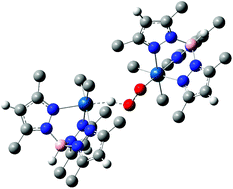Mechanistic examination of aerobic Pt oxidation: insertion of molecular oxygen into Pt–H bonds through a radical chain mechanism†
Abstract
DFT calculations were performed in an effort to evaluate the mechanism of O2 insertion into the Pt–H bond of TpMe2PtIVMe2H catalyzed by AIBN or light. Results are consistent with a radical chain mechanism involving H˙ loss to form a PtIII˙ species followed by addition of O2 to form PtIIIOO˙. Subsequent radical propagation involving this PtIIIOO˙ species and an additional equivalent of the PtIV starting material result in the formation of the observed PtIVOOH and regeneration of the PtIII˙. In addition examination of the reaction between AIBN and the PtIV hydroperoxo product demonstrates that radical initiation reactions involving the product occur with a lower barrier than with the initial starting material supporting the idea of autoacceleration in this reaction. Other possible mechanisms were examined in an effort to understand the limited reactivity reported in the absence of light or radical initiators. TDDFT calculations were performed in an effort to understand the reported parallel photo-induced reaction. These calculations found the reactant to be transparent in the relevant light range. An experimental UV-Vis spectrum was obtained and is in agreement with the calculations.

- This article is part of the themed collection: New Talent: Americas

 Please wait while we load your content...
Please wait while we load your content...